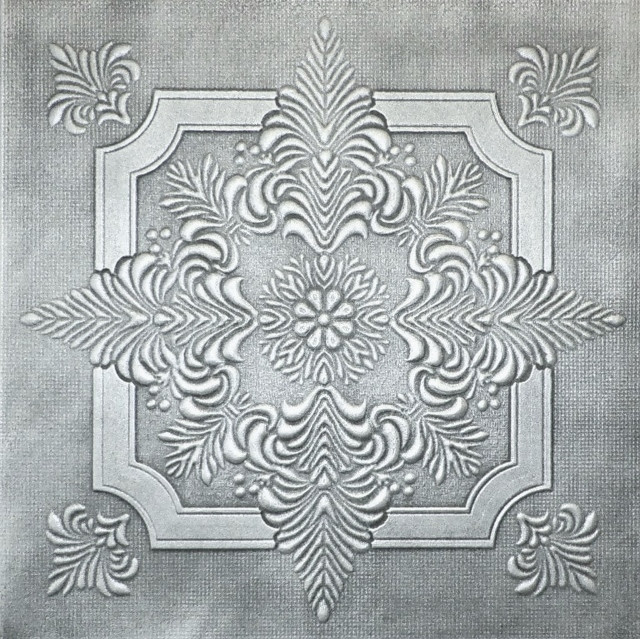

Prices can go up to $8.00 or $9.00 per square foot for very thick tiles that are designed to provide outstanding sound absorbing performance.Īrmstrong is the largest provider of residential fiberglass ceiling tiles but there are other brands including Top Tile. Most inexpensive Fiberglass ceiling tiles cost about $.50 to $1.50 per square foot.

Because Fiberglass tiles are laminated with vinyl, painting them is not recommended. Most Fiberglass tiles are available in a 2’ x 4’ size and for installation into drop ceiling grids. Fiberglass is usually selected when thermal or acoustic properties are desired. Tiles are mainly white and lightly textured.
#Painting styrofoam ceiling tiles professional#
They are maintenance-free and durable, but careful, or professional installation is necessary to prevent the fiberglass material from breaking loose.įiberglass tiles are easy to find but there are not as many styles available as there are with some of the other materials. Fiberglass tiles provide insulating properties and are very good at absorbing sound. Fiberglass Ceiling Tilesįiberglass ceiling tiles are another inexpensive choice and are made from glass fibers encased in resins and formed into tiles. You can find selections of USG, Armstrong, and other brands of Mineral Fiber ceiling tile at most home improvement stores. For instance, the Armstrong Tincraft profile tile, which has been embossed to replicate the look of an antique tin ceiling, costs around $6.50 per square foot. Mineral Fiber ceiling tiles can cost more depending on the thickness of the tile, the texture, and level of moisture and stain protection that the tiles have been treated with. Armstrong also offers a number of inexpensive Mineral Fiber ceiling tiles in all 3 sizes with costs from $1 to $2.50 per square foot. Costs for lightly textured tiles in their Budget Line, including the Stonehurst and Adobe profiles, range from $.50 to $1 per square foot. USG makes a large variety of cheap Mineral Fiber ceiling tiles in 2’ x 2’, 2’ x 4’ and 12" x 12" sizes. These tiles can be painted with latex paints but paint will slightly reduce their sound absorbing abilities by filling some of the crevices. Mineral Fiber ceiling tiles can be used in almost any room, except a bathroom, as long as the tiles have been treated with a moisture protection product. You can find them in 2’ x 2’ and 2’ x 4’ sizes for standard drop ceilings and in 12” x 12” sizes made to be mounted directly to the ceiling surface with an adhesive. Mineral Fiber tiles are very common and widely available. However, the tiles on the market today are generally treated with products making them resistant to these issues – at least for a time. When they do, they are prone to mold, mildew and sagging. Mineral Fiber tiles are not very durable and will absorb moisture in damp areas. Many of the tiles are made with fissures or perforations to give them better acoustical properties. Because the tiles are wet-formed, they can be pressed to replicate the appearance of tin ceilings or heavy stucco. The tiles are available in many textures from smooth to heavily textured. Mineral fiber tiles are made from various recycled materials including paper, fiberglass, perlite, and mineral wool combined with binding agents and formed into tiles. You can find these tiles, as well as other brands, at most big box home improvement stores. Fiberboard ceiling tiles can easily be painted. Their Alpine profile features more acoustic properties and costs about $.95 per square foot, which is still pretty cheap – less than $200 for a 12x15 room. USG makes a variety of fiberboard ceiling tiles in 2’ x 2’ and 2’ x 4’ sizes with costs between $.55 and $.65 per square foot for their Fifth Avenue and Radar profiles. Some fiberboard tiles have been treated to resist moisture damage and sagging but this will make the tiles slightly more expensive.įiberboard ceiling tiles would not be a good choice for a humid environment like a damp basement or bathroom. While fiberboard is the one of the cheapest ceiling tiles materials, it is not the most common because it is not durable and is susceptible to mold, mildew, sagging, staining, and water damage. Fiberboard is one of the least expensive types of ceiling tile.


 0 kommentar(er)
0 kommentar(er)
